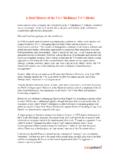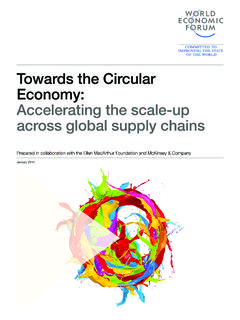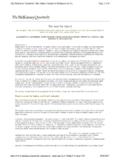Transcription of Future of Mobility: Trends and implications
1 Future of Mobility: Trends and implications CONFIDENTIAL AND PROPRIETARYAny use of this material without specific permission of mckinsey & Company is strictly prohibitedOFVOslo | December 20172 mckinsey & CompanyShifting mobility market and trendsElectrifying the Future Future of urban commercial mobilityOutlook for EuropeAgenda3 mckinsey & CompanyFor more than 2 years, the industry has been talking about disruptive Trends that have the potential to radically change the mobility industrySOURCE: mckinsey Center for Future Mobility4 disruptive technology-driven Trends .. ElectrificationConnectivityand IoTAutonomous drivingDiverse radically changing the mobility industry Shifting markets and revenue pools Diffusion of advanced technology Changes in mobility behavior and new business models Increasing investments New competition and cooperation4 mckinsey & CompanyOver the past 2 years, significant additional momentum has been built up along all four disruptive Trends , and continues to do soExamplesSOURCE.
2 mckinsey Center for Future totomorrow51% of models announced until 2021 will have of vehicles soldhave xEVpowertrains80% of the top 20 OEMs are planning to have AV L4+by 20251-2% of vehicles sold are equipped with basic partial automation (L2) technologies16% of customers already reported they would use shared mobility in the Future <1% of passenger miles travelled currently carried out using shared mobilityPercentage of consumers ready to change car brand for better connectivity doubled in last 2 years12% of cars equipped with embedded connectivity, generating revenues of less than $ billionSustainable mobilityAutonomous drivingShared mobilityConnectivity5 mckinsey & CompanyCurrent and Future annual global vehicle sales, millions Driven by urbanization and macroeconomics, global vehicle sales will continue to grow, although at a slower pace41231058710115 Fewer privatevehiclesMacro-economicgrowth2015 Privatevehicles2030 NewsharedvehiclesHIGH-DISRUPTIONSCENARIO SOURCE.
3 mckinsey Center for Future MobilitySHIFTING MARKETS AND REVENUE POOLS6 mckinsey & Company20302016 With disruptive scenarios becoming more likely, the share of revenues from disruptive business models could increase to 20-25% by 2030 Automotive revenues based on consumer spend in 2016 and 2030 SOURCE: mckinsey Center for Future Mobility"Disruption to personal mobility" scenario, USD bnShared mobilityOne-time vehicle sales(incl. xEV and AV)Aftermarket2,6001,27035~ 6,6001,325 Data-enabled services(connectivity)12508403,800~ 3,500 Disruptive business modelsTraditional business models1 revenues only, not comprising cost saving potentials7 mckinsey & CompanyA more granular perspective on geographical areas and city archetypes becomes ever more important due to differing growth rates1 Vehicle sales revenue adjusted from consumer spend to reflect OEM addressable revenues.
4 Including removal of VAT, import tariffs, shipping costs, and dealer margin2 Global CAGR of across all geographies and city archetypes3 Based on disruptive scenario, 80-90% ridesharing app adoption, 10x growth in rideshare vehicle miles traveled by 2030, 100% connectivity saturation by 2021, ~50% of vehicles sold electrified by 2030 Traditional1and new automotive revenues 2030 : mckinsey Center for Future of World China18 Europe2211 Rest of Asia NAFTA2522 Small towns3019 Developing suburban cities10 Developed suburban cities19 Developed dense citiesDeveloping dense dense citiesDense citiesRevenue by geography2015 -2030 CAGR2 Revenue by city archetypes32015 -2030 CAGR28 mckinsey & Company1 1076 Companies. Using selected keywords and sample startups, we were able to identify a set of similar companies according to text similarity algorithms (similarity to companies business description) used by the Competitive Landscape Analytics (CLA) team.
5 Companies used were pulled from Capital IQ and were filtered by year founded greater than 19902 Until September 2017 SOURCE: Start-up Investment Analytics (SILA); CapitalIQ; Pitchbook; McKinseySILA analysis identified strong acceleration of investment activities with few big industry shaping moves and many small + disclosed investment amount since 2010 USD bnAverage invest , USD bn2014-172 Technology clusters12010-136x increase in average funding from 2010-13 to 2014-17 leasing and fleet and cyber and mobility interface >USD 1bn<USD 1bnSingle transactionSmart MobilityElectrificationConnectivity51278 349106 Autonomous171,248# Transactions9 mckinsey & CompanyShifting mobility market and trendsElectrifying the Future Future of urban commercial mobilityOutlook for EuropeAgenda10 mckinsey & CompanyShort term, four key drivers will drive EV market dynamicsSOURCE.
6 mckinsey Sustainable Mobility InitiativeE-MOBILITY Trends Vehicle sales projected to grow by ~2% until 2030 Oil prices could rise meaningfully within next 10 years1 | Macroeconomics CO2targets, real driving emissions changes, and Dieselgate generates headwinds for Future investments in diesel tech Local regulations on city level as a driving force for EV roll-outRegulation and incentives Battery prices could fall between $100-190/kWh for battery packs by 2020, and continue to fall Charging infrastructure rollout could accelerate in key markets (US, EU, China)3 | Technology Up to ~50% of car buyers consider an EV based on survey insights Top EV purchase barriers -price and model variety -likely to dissipate 4 | Customer demandE-mobilityindustrydynamics2 |11 mckinsey & CompanyMacroeconomic Trends will help facilitate SOURCE: mckinsey Global Growth Model, Federal Reserve Bank of St.
7 Louis ; UN Population Division; IHS, mckinsey Sustainable Mobility Initiative MACROECONOMICS1 8 recession periods since 1947; occurrence every years, last recession in 20092 Companies exiting the market, lower investment, potentially more OECD cooperation Rising oil prices and declining battery prices could put EVs at cost parityin some scenarios by 2020-25 Trend through 2030 Oil prices could recover2with rising prices in the next 10 yearsImplication on EVsMacroeconomicsEVs may be favored over conventional vehicles in cities due to zero emissions targetsGlobalurban population couldincrease by~ bnbetween 2016-30 UrbanizationRobust and lean powertrain/EV portfolio required to adapt quickly to changing mobility Trends and sustain economic downturnsGlobal economies expected to grow by until 2030, with 2 recessions1(in the US)
8 Expected through 2030 GDP growthOil price1 Growth drivenby urbanand sharedmobility that favors EVs over conventional carsDespite shared mobility Trends global vehicle sales expected to grow by 2% through 2030 Vehicle sales12 mckinsey & CompanyCO2regulation is a key factor for EV penetration1 To ensure comparability, CO2 figures are cycle-adjusted and normed (to NEDC)SIMPLIFIED World of today Mix of powertrains EV world Increase in regulation of CO2 g/km12015202020252030 Corridor for potential CO2 regulation CO2g/km13012114495~501721669610768-78180 15010050 YearRegulationcorridor~70~80 EstimateCommunicatedRequired powertrain portfoliosUntil 100g CO2/km, a portfolio of ICE, mild-hybrids, and less than 10% electrification can meet targetsBelow 100g CO2/km, a portfolio game with equal importance of ICE, PHEVs, and EVs can meet regulationsBelow 50g CO2/km, a portfolio mainly consisting of EVs and PHEVs is required2 SOURCE: mckinsey Sustainable Mobility Team DRIVERS FOR E-MOBILITY AND MARKET OUTLOOK13 mckinsey & Company5405995001003001,0009008000400600 20070020161526920101114-77%1213140642202 2E8001,000227 SOURCE.
9 IHS, Bloomberg, New Energy Finance, IEA report on GlobalEVOutlook2017, mckinsey Sustainable Mobility Team Battery price declines transform into increased range for EVsWeighted average battery pack priceand indicative ranges, $ per the car parkMillion unitsWeighted average range of BEVsin the car park,Miles2118191417152022E201620111213 Projected1 Actural<100 miles100-200 miles 200 miles1 US Department of Energy target in 2022 Biggest improvements in battery cost will be driven by technology jumps and scale effects3 DRIVERS FOR E-MOBILITY AND MARKET OUTLOOK14 mckinsey & CompanySOURCE: mckinsey Sustainable Mobility Initiative 2016 Electrified Vehicle Consumer SurveysPercentage of responses, US and Germany, 2016 Between almost 30 and 45% of vehicle buyers in the US and Germany respectively consider an EV purchase today4 ICE models10010096739650443 Germany9650294 USEV models(BEV +PHEV)Percentage of consumers that identify themselves at each purchase funnel stageConsiderationFamiliarityAwarenessPu rchaseDRIVERS FOR E-MOBILITY AND MARKET OUTLOOK15 mckinsey & CompanyIn 2019/20, the number of available BEV models will increase dramatically this could become a tipping point in EV adoptionSource: IHSM arkitAutomotive; Press.
10 McKinsey1 Excluding Light Commercial vehicles (LCVs)AnnouncednewBEV modelsABCDES egmentStart of Production : newCO2 limits125151412413123134463243231223 Producedin 2017E-MOBILITY MARKET OUTLOOK16 mckinsey & : Tony SebaTECHNOLOGICAL PARADIGMCHANGESOFTENOCCURVERYRAPIDLYN ohorsesLots ofhorses, onelonelycar5th Avenue, NYCE xponential technological progress combined with disruptive social dynamics ( tipping points in consumer behavior) makeforecasting speed and magnitude of change very difficult 19001913E-MOBILITY ECOSYSTEM AND VALUE CHAIN UNBOUND17 mckinsey & CompanyShifting mobility market and trendsElectrifying the Future Future of urban commercial mobilityOutlook for EuropeAgenda18 mckinsey & CompanyCommercial vehicles contribute more than their fair share of emissions vs private vehicles%London70928~30 China (nationwide)1853015 Car parc2 NOx 3~70 SOURCE.







